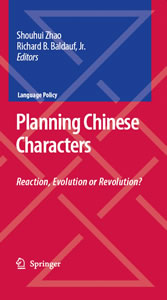Suchen und Finden
Service

Planning Chinese Characters - Reaction, Evolution or Revolution?
Shouhui Zhao, Richard B. Jr. Baldauf
Verlag Springer-Verlag, 2007
ISBN 9780387485768 , 418 Seiten
Format PDF
Kopierschutz Wasserzeichen
DEDICATION
6
Contents
7
Authors
9
Abbreviations
11
Preface
12
Foreword
14
PROLOGUE
19
1. THE ORIGINS OF HANZI
19
2. STRUCTURE EVOLUTION – FROM PICTURES TO SYMBOLS
21
2.1 Oracle Bone Inscription ( jiaguwen, jiaguwen, jiaguwen, jiaguwen, ).
22
2.2 Bronze Inscription ( jinwen, jinwen, jinwen, )
23
2.3 Small Seal Script4 (xiaozhuan, xiaozhuan, xiaozhuan, )
24
2.4 Clerical Script ( lishu, lishu, lishu, )
25
2.5 Square Script (kaishu, kaishu, kaishu, )
26
2.6 Summary of Historical Development
27
3. CHARACTERISTICS OF CHINESE HANZI
27
3.1 Abstraction: From Pictogram and Ideogram to Phonogram
27
3.2 Structural Complexity
30
3.3 An Open-Ended Number of Characters
33
3.4 Artistic Features: Writing Stylization, Print Fonts
35
4. PROLOGUE SUMMARY
39
Chapter 1 MAKING HANZI ACCESSIBLE
41
1. INTRODUCTION
41
2. HANZI UNIFICATION AND STANDARDIZATION IN DYNASTIC CHINA
42
2.1 One State, One Script – Qin Empire
43
2.2 Subsequent Developments Prior to Modern China
44
2.3 Standardization Summary
45
3. THE FIRST SIMPLIFICATION SCHEME IN 1935
46
3.1 Background Review
48
3.2 Exploring Reasons for Failure: Cultural Continuity
49
3.3 Implications for the Forthcoming Reforms
56
3.4 Government vs Individuals
56
3.5 Methodological Issues
58
4. SIMPLIFICATION MOVEMENTS IN THE 1950s AND 1960s
59
4.1 Dynamic Intervention from the State – Organizational Change
59
4.2 A Tentative Evaluation of the Table of Simplified Characters of 1956 – Periodic Success
63
5. SECOND SIMPLIFICATION SCHEME (SSS) ( 1977)
69
5.1 Political Presence in Chinese Characters and Character Planning
70
5.2 Formalization and Implementation
72
5.3 Factors That Led to the Abandonment
82
5.4 Summarizing the Second Simplification Scheme
86
Chapter 2 REFLECTIONS ON NEW PERSPECTIVES
88
The Opening Up of Chinese Society
88
1. SCRIPT REFORM TRANSFORMED: REFLECTION AND RE- ORIENTATION
88
1.1 Adjustment to Meet the Needs of a New Society – NCLW ( 1986)
89
1.2 Reflection on Past Experience
92
2. SOCIO-POLITICAL ASPECTS OF THE TRANSFORMATION
107
2.1 Chaotic Situation During Social Transition
107
2.2 A Sociolinguistic Analysis of Character Use
110
2.3 The Polemic (Debate) on hanzi’s Future
113
Chapter 3 NEW CHALLENGES FOR A DIGITAL SOCIETY
127
1. INTRODUCTION
127
2. DEALING WITH THE PROBLEMS OF A DIGITAL SOCIETY
128
2.1 Chinese Character’s Machine Applications
128
2.2 Three Streams of Input Schemes
133
3. INTERNET USE OF CHINESE CHARACTERS
143
3.1 Some Technical Issues in Encoding and Decoding Chinese Characters
144
3.2 Decoding Chinese Information on Web Pages
146
3.3 E-mail Use on Non-Chinese Language Computers
148
3.4 Summarizing the On-line Dilemma
150
Chapter 4 STANDARDIZATION AS A SOLUTION
152
Multiple Standards for Specific Purposes
152
1. INTRODUCTION
152
2. A NEW ROUND OF STANDARDIZATION: A SOCIOLINGUISTIC SOLUTION TO TECHNOLOGICAL IMPACT
154
2.1 Tackling the Total Number of Chinese Characters
154
2.2 Shape – Developing a Higher Standard for Physical Uniformity
171
2.3 Sound – Reducing Pronunciation Variation
177
2.4 Ordering – Standardizing the Referencing Methods
183
3. CURRENT STANDARDIZATION PROJECTS
189
3.1 Systematic Optimization and Modification: CTSC
190
3.2 Overhauling the Repertoire of Chinese Writing System: Corpus of Whole Chinese Characters
200
4. TENTATIVE SUMMARY
204
Chapter 5 INFLUENCING OUTCOMES
206
Sociolinguistic Analysis of Non-Character-based Issues
206
1. INTRODUCTION
206
2. LINGUISTIC RESEARCH AND ACCOMPLISHMENTS OF LP
208
2.1 New Functions for Pinyin and Putonghua
209
2.2 Implications of Linguistics Science
211
3. TECHNOLOGY AND ECONOMIC DEVELOPMENT AS A CATALYST
216
3.3 The Outcome of Economic Development
218
4. SOCIO-DEMOGRAPHIC FEATURES
223
4.1 Widespread Literacy
223
4.2 Awareness of Democracy
226
4.3 Regionalism
227
4.4 Down to Reality
229
5. POLITICAL CLIMATE ACROSS THE TAIWAN STRAIT
230
5.1 The Source of the Difference: Political Rift
230
5.2 Stability and Unification: From Maintaining the Status Quo to Moving Closer
232
5.3 Looking into the Future: Planning for Unification
233
6. POPULAR CULTURE – SHIFTING ATTITUDES TOWARDS CULTURE AND CHARACTERS
235
7. THE IMPACT OF THE INTERNAL POLITICAL CLIMATE
237
7.1 The Shift of the Party’s Propaganda Strategy
238
7.2 Leadership – Political Individual Involvement at the National Level
240
7.3 Integration of Ongoing Political Campaigns into LP Work
251
8. INTERNATIONAL ENVIRONMENT
254
8.1 International Comparison and Cooperation
254
8.2 Ideological Factors from a Historical Perspective
256
8.3 Coping with Recent Reality
257
8.4 National Interest
258
9. SUMMARY AND CONCLUSIONS
261
Chapter 6 ENVISIONING THE FUTURE
263
Trends and Strategies
263
1. INTRODUCTION
263
2. TOWARD A PLURICENTRIC STANDARD MODEL
264
2.1 and Democratization The Socio- political Context: Diversification
265
2.2 Framework of a Pluricentric Standard
268
2.3 Deliberation on the Notion of Standardization
270
2.4 The Ongoing Exploration – Toward a Framework for the Future
277
3. LANGUAGE REFORM MODERNIZATION
281
3.1 Theoretical Framework
282
3.2 The Importance of Language Planners and Stakeholders Agreeing on a Standard
285
3.3 Challenging Existing Practices – Experiences and Realities
286
3.4 Looking for a Way Forward
294
Chapter 7 SOME CRITICAL ISSUES
300
Historical and Current
300
1. INTRODUCTION
300
2. ROMANIZATION – OLD QUESTION, NEW CHALLENGE
301
2.1 Renewed Interest in Romanization and Digraphia
302
2.2 Technological Impact and Technological Issues
307
2.3 Romanization or Hanzi? Still a Question
309
3. CRACKING THE HARD NUT: DEALING WITH THE RESCINDED SECOND SCHEME AND BANNED TRADITIONAL CHARACTERS
312
3.1 Systematic Optimization and Modification:
312
3.2 Small Compromise for Big Convenience: Partial Re- Introduction of the Traditional Characters
320
3.3 Tentative Summary
324
4. ‘COMMON SCRIPT’ ACROSS CYBERSPACE
326
4.1 Han-Unification – Diversity and Difficulty
327
4.2 Socio-Political Dimensions
330
5. HANZI REFORM: A BATTLEFIELD FOR SOCIAL FORCES IN LANGUAGE PLANNING
335
5.1 Rearticulating Some Underlying Issues
335
5.2 Evolution
336
5.3 Revolution
338
5.4 Reaction
339
5.5 Conclusion
340
Acknowledgments
342
Appendix
344
Notes
374
PROLOGUE
374
CHAPTER 1
375
CHAPTER 2
378
CHAPTER 5
382
CHAPTER 6
385
CHAPTER 7
387
References
389
Content Index
419
Author Index
426


















